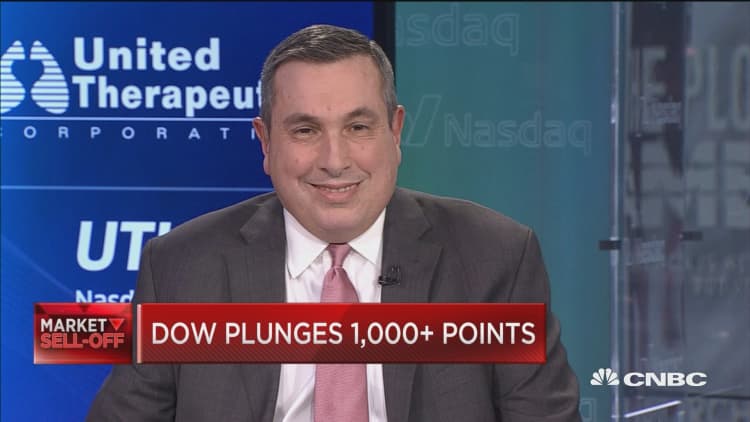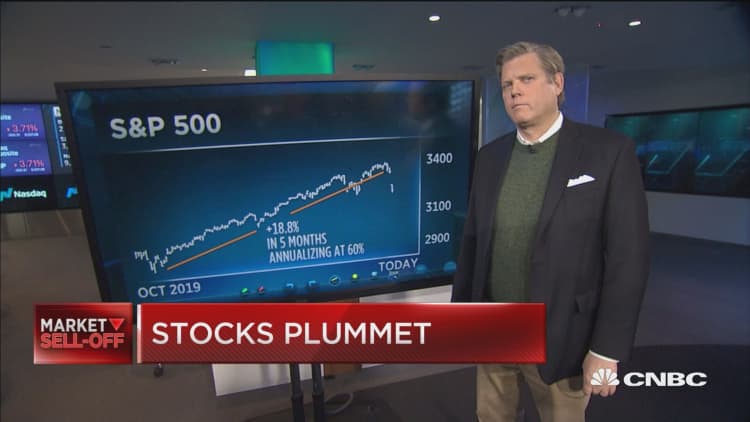
The U.S. stock market's sharp sell-off on Monday came after coronavirus cases increased outside of China, but there were several other factors that may have helped send stocks downward.
The Dow Jones Industrial Average and the S&P 500 both fell more than 3% on the day, with travel stocks and those with heavy reliance on supply chains in China and South Korea, such as Apple, falling more than the broader market.
Strategists and technical analysts pointed to other signals in the market that helped fuel a sell-off that the outbreak had failed to trigger so far.
Technical indicators
A lack of market breadth is one area that showed weakness, JC O'Hara of MKM Partners said in a note to clients over the weekend. With the best performers this year being concentrated in a small group of tech stocks, a downturn for those stocks could result in a spill over to the broader market, O'Hara said.
"The market is becoming very narrow in terms of stocks that have outperformed the S&P 500 over the last three months. Currently, this is the smallest group of winners since the 2007 market top," O'Hara said in a note to clients over the weekend.

O'Hara also noted that the market's slump at the end of last week brought the S&P 500 close to dropping below its 50-day moving average, a key level watched by technical traders. The index broke through that level on Monday as soon as trading began.
Rick Bensignor of Bensignor Investment Strategies said in a note to clients that weakness in oil prices and emerging markets meant that stocks falling below similar indicators could signal a deflationary period across asset classes.
Investor sentiment also seemed not to have priced in some of the risks from the outbreak, strategists said. The American Association of Individual Investors reported last week that 40.6% of investors were bullish, above the historical average of 38%.
Bruce Bittles of Baird said in a note to clients on Monday that investors seemed too complacent in recent weeks, making the market susceptible to a pullback.
"Since there is so much uncertainty surrounding the coronavirus impact on the global economy, the optimism seems to have gotten ahead of itself leaving the markets vulnerable should the virus news worsen or global economic conditions deteriorate further," Bittles said.
Bernie Sanders
Another issue that could be spooking investors is the rise of Vermont Sen. Bernie Sanders, whose win in the Nevada caucuses on Saturday firmly made him the front-runner in the Democratic presidential primary.
"Saturday's caucus in Nevada saw Senator Bernie Sanders emerge as a big winner, demonstrating his ability to put together a broad coalition of supporters and demolishing the argument that he can't attract minority supporters," L. Thomas Block, Fundstrat's Washington policy strategist, said in a note.
Many health care stocks fell on Monday after the big win for Sanders, whose Medicare-for-all plan would move Americans onto a government-run health insurance program and eliminate private insurance.
Centene was one of the biggest losers on the day, plunging 9.4%. UnitedHealth Group and Humana were also pummeled, falling 7.8% and 6.3%, respectively.
Risk-off
Additionally, the sell-off was not only limited to companies that seemed to be impacted by recent headlines. There was a broader move toward a risk-off mentality among investors.
Stocks like Microsoft and Netflix, which have little to worry about in regards to supply chain issues in Asia, fell 4.3% and 3.0% respectively.
Meanwhile, the yield for 10-year Treasurys hit a three-year low and the 30-year hit its lowest level ever as investors looked for safer assets. The least negative sector in the S&P 500 was utilities, at -1.16% for the day, another signal that investors were looking for safer opportunities for yield.


